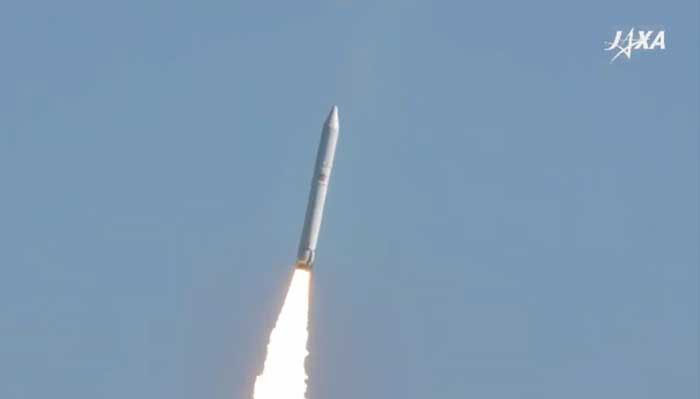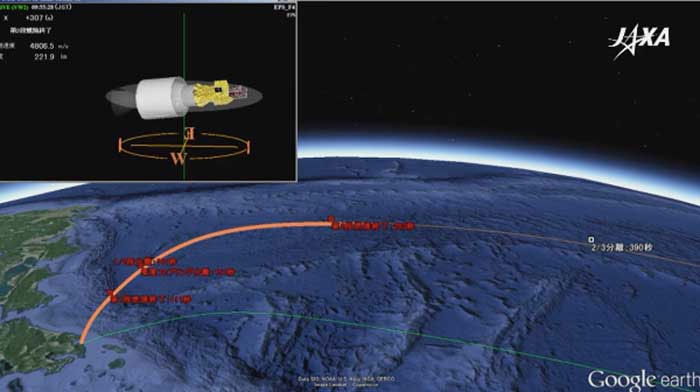Vietnamese satellite satellites are successfully launched into space
More than an hour after the launch was successful, the new MicroDragon satellite separated from the rocket to get into orbit and perform the observation mission.
At 7:50 am Hanoi , Vietnam Satellite MicroDragon and 6 Japanese satellites leave the flight launcher into orbit with Epsilon boosters. Six Japanese satellites include: JAXA's small satellite (200 kg); 3 micro-satellites (60 kg) of Tohoku University, ALE-1 (68 kg) of ALE company and 3 cubesat satellites (4 kg) and some other satellites weighing from 1 to 3 kg.
According to Dr. Pham Anh Tuan, Director of the National Satellite Center (VNSC), after launching into space, MicroDragon will be separated from boosters in the sky of Cuba. About a day or two after the ground station can receive the first signals from the satellite. After a period of one to three months of experimental activity in the universe, satellites will operate stably.


Simulate the journey of missiles and satellites.
Before the implementation of separation of boosters from the launch pad, at 7:25 Japan Aerospace Research and Development Agency (JAXA) introduced images of the process of studying the manufacture of satellites, simulating the defense process. fine separation from rockets and active in the universe .
Japanese and Vietnamese experts are present at the Center to control the missile in a position that is set to miss a 3km missile.
Earlier, the satellites were installed on the No. 4 Epsilon missile at Uchinoura Space Center, Japan. Experimental and testing activities have been reviewed by experts, ready for the plan to fly into the orbit of satellites. Ground stations in Japan are also set up, ready for operating and analyzing data from satellites.
50kg weight designed and manufactured by VNSC engineers under the guidance and technical support of experts from JAXA and professors of Kyushu Technological and Kyushu Technological Technology Institute.
This is the second satellite manufactured by VNSC with the task of observing the coastal waters in order to assess water quality, locate aquatic resources, and monitor the changes of occurrences in coastal waters.
MicroDragon uses 2 multi-spectral cameras with adjustable liquid crystal filter (LCTF) captured in 12 spectral bands (from 412nm to 1020nm), best ground resolution image is 78m, image size is approximately 36 × 48km when satellites operate in 511km orbit.
Having the MicroDragon satellite image in the desired location is the basis for exchanging satellite data with the micro community around the world, thereby enhancing the ability to respond quickly to activities such as disaster prevention and variability. climate change.
In addition, MicroDragon satellite images can be used to combine data with available remote sensing data to search for new applications or enhance the quality of old applications to confirm the applicability of satellite lines. micro.
Micro Dragon is the next step in the process of gradually grasping and mastering the technology of satellite design and manufacturing in Vietnam. Previously, VNSC engineers successfully built PicoDragon micro-satellite (10 x 10 x 11.35 cm in size and 1 kg in weight). After Micro Dragon, NanoDragon satellite is being researched and developed in Vietnam by VNSC's engineers and experts.
- SpaceX successfully launched 10 Iridium Next satellites into space
- American private company launched the first commercial satellite
- France launched telecommunications satellites for India and Qatar
- Europe has successfully launched 2 telecommunications satellites
- Eutelsat 3В telecommunications satellite successfully launched into orbit
- Russia successfully launched the Dutch telecommunications satellite
- Japan launches satellites into space
- MicroDragon satellite and the dream of reaching the Vietnamese space
- SpaceX successfully launched the SES-9 satellite into orbit, failing to land missiles on barges
- India successfully launched the second IRNSS positioning satellite
- Successfully launched the AsiaSat 6 satellite rocket into orbit
- Europe has successfully launched two telecommunications satellites
 Vietnam 5th Asian champion on fuel-efficient vehicles
Vietnam 5th Asian champion on fuel-efficient vehicles We can read all NASA studies completely free of charge
We can read all NASA studies completely free of charge Singer and songwriter Bob Dylan won the 2016 Nobel Prize for Literature
Singer and songwriter Bob Dylan won the 2016 Nobel Prize for Literature Scientific revolution in Asia
Scientific revolution in Asia